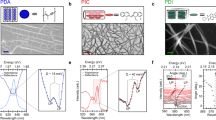Abstract
The modification and control of exciton–photon interactions in semiconductors is of both fundamental1,2,3,4 and practical interest, being of direct relevance to the design of improved light-emitting diodes, photodetectors and lasers5,6,7. In a semiconductor microcavity, the confined electromagnetic field modifies the optical transitions of the material. Two distinct types of interaction are possible: weak and strong coupling1,2,3,4. In the former perturbative regime, the spectral and spatial distribution of the emission is modified but exciton dynamics are little altered. In the latter case, however, mixing of exciton and photon states occurs leading to strongly modified dynamics. Both types of effect have been observed in planar microcavity structures in inorganic semiconductor quantum wells and bulk layers1,2,3,4,5,6,7,8. But organic semiconductor microcavities have been studied only in the weak-coupling regime9,10,11,12,13,14,15,16,17,18. Here we report an organic semiconductor microcavity that operates in the strong-coupling regime. We see characteristic mixing of the exciton and photon modes (anti-crossing), and a room-temperature vacuum Rabi splitting (an indicator of interaction strength) that is an order of magnitude larger than the previously reported highest values for inorganic semiconductors. Our results may lead to new structures and device concepts incorporating hybrid states of organic and inorganic excitons19, and suggest that polariton lasing20,21,22 may be possible.




Similar content being viewed by others
References
Weisbuch, C. et al. Observation of the coupled exciton-photon mode splitting in a semiconductor quantum microcavity. Phys. Rev. Lett. 69, 3314–3317 (1992).
Houdré, R. et al. Room-temperature cavity polaritons in a semiconductor microcavity. Phys. Rev. B 49, 16761–16764 (1994).
Burstein, E. & Weisbuch, C. (eds) Confined Electrons and Photons (Plenum, New York, (1995)).
Skolnick, M. S., Fisher, T. A. & Whittaker, D. M. Strong coupling phenomena in quantum microcavity structures. Semiconductor Science & Technology (in the press).
Yamamoto, Y. et al. in Coherence, Amplification, and Quantum Effects in Semiconductor Lasers (ed. Yamamoto, Y.) 561–615 (Wiley, New York, (1991)).
Ünlü, M. S. & Strite, S. Resonant cavity enhanced photonic devices. J. Appl. Phys. 78, 607–638 (1995).
Sale, T. E. Vertical Cavity Surface Emitting Lasers (Wiley, New York, (1995)).
Kelkar, P. et al. Excitons in a II–VI semiconductor microcavity in the strong-coupling regime. Phys. Rev. B 52, R5491–R5494 (1995).
Nakayama, T. & Kakuta, A. Organic luminescent devices with a mutliplex cavity structure. Jpn. J. Appl. Phys. 34, L1234–L1236 (1995).
Tsutsui, T. et al. Sharply directed emission in organic electroluminescent diodes with an optical-microcavity structure. Appl. Phys. Lett. 65, 1868–1870 (1994).
Dodabalapur, A. et al. Microcavity effects in organic semiconductors. Appl. Phys. Lett. 64, 2486–2488 (1994).
Jordan, R. H. et al. Efficiency enhancement of microcavity organic light emitting diodes. Appl. Phys. Lett. 69, 1997–1999 (1996).
Lidzey, D. G. et al. Control of photoluminescence emission from a conjugated polymer using an optimised microcavity structure. Chem. Phys. Lett. 263, 655–660 (1996).
Lidzey, D. G. et al. Mapping the confined field in a microcavity via the emission from a conjugated polymer. Appl. Phys. Lett. 71, 744–746 (1997).
Lidzey, D. G. et al. Pixelated multicolour microcavity displays. Spec. Topics Quantum Electron. 4, 113–118 (1998).
Grüner, J. et al. Optical-mode structure in a single-layer polymer microcavity. Synth. Met. 76, 137–140 (1995).
Tessler, N. et al. Lasing from conjugated-polymer microcavities. Nature 382, 695–697 (1996).
Diaz-Garcia, M. A. et al. Plastic lasers: comparison of gain narrowing with a soluble semiconducting polymer in waveguides and microcavities. Appl. Phys. Lett. 70, 3191–3193 (1997).
Agranovich, V. et al. Organic and inorganic quantum wells in a microcavity: Frenkel-Wannier-Mott excitons hybridization and energy transformation. Solid State Commun. 102, 631–636 (1997).
Kira, M. et al. Quantum theory of nonlinear semiconductor microcavity luminescence explaining “boser” experiments. Phys. Rev. Lett. 79, 5170–5175 (1997).
Jahnke, F. et al. Excitonic nonlinearities of semiconductor microcavities in the nonperturbative regime. Phys. Rev. Lett. 77, 5257–5260 (1996).
Kelkar, P. V. et al. Stimulated emission, gain, and coherent oscillations in II–VI semiconductor microcavities. Phys. Rev. B 56, 7564–7573 (1997).
Nelson, T. R. et al. Room-temperature normal-mode coupling in a semiconductor microcavity utilizing native-oxide Al Al/GaAs mirrors. Appl. Phys. Lett. 69, 3031–3033 (1996).
Norris, T. B. in Confined Electrons and Photons (eds Burstein, E. & Weisbuch, C.) 503–521 (Plenum, New York, (1995)).
Grice, A. W. et al. Ablue emitting triazole based conjugated polymer. Adv. Mater. 9, 1174–1178 (1997).
Dolphin, D. (ed.) The Porphyrins (Academic, New York, (1978)).
Kalyanasundaram, K. Photochemistry of Polypyridine and Porphyrin Complexes (Academic, New York, (1992)).
Marks, R. N. The photovoltaic response in poly(p-phenylene vinylene) thin film devices. J. Phys. Cond. Matt. 6, 1379–1394 (1994).
Alvarado, S. et al. Determination of the exciton binding energy in conjugated polymers via STM injection measurements. Phys. Rev. Lett. (in the press).
Strickler, S. J. & Berg, R. A. Relationship between absorption intensity and fluorescence lifetime of molecules. J. Chem. Phys. 37, 814–822 (1962).
Acknowledgements
We thank T. Richardson for the 4TBPPZn samples. D.G.L. thanks Lloyds of London for a Tercentenary research fellowship and D.D.C.B. thanks the Leverhulme Trust for a Leverhulme fellowship. This work was supported by the UK Engineering and Physical Sciences Research Council.
Author information
Authors and Affiliations
Corresponding author
Rights and permissions
About this article
Cite this article
Lidzey, D., Bradley, D., Skolnick, M. et al. Strong exciton–photon coupling in an organic semiconductor microcavity. Nature 395, 53–55 (1998). https://doi.org/10.1038/25692
Received:
Accepted:
Issue Date:
DOI: https://doi.org/10.1038/25692
- Springer Nature Limited
This article is cited by
-
Activating cavity by electrons
Communications Physics (2023)
-
Plasmon mediated coherent population oscillations in molecular aggregates
Nature Communications (2023)
-
Drastic transitions of excited state and coupling regime in all-inorganic perovskite microcavities characterized by exciton/plasmon hybrid natures
Light: Science & Applications (2022)
-
Energy cascades in donor-acceptor exciton-polaritons observed by ultrafast two-dimensional white-light spectroscopy
Nature Communications (2022)
-
All-optical control of phase singularities using strong light-matter coupling
Nature Communications (2022)





